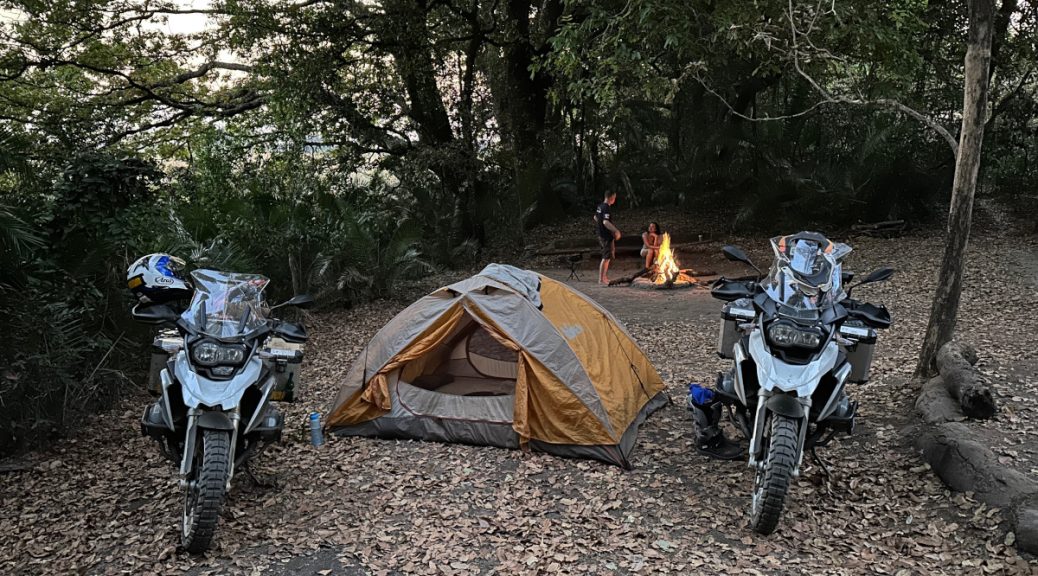A motorbike trip to Zambia allows for expansive exploration through gorgeous natural environments and parks, while relaxing with stunning views and even hot springs. Not to be missed. By Tim Tucker, Carolyn Williamson, Malose Mamashela and Andrew Brown
The thought of going back to Zambia – this time on two wheels – gave us all such excitement that we just had to get on the road. So, off we went on a three-week adventure, after trucking our motorbikes from Cape Town to Kasane in Botswana (thanks Christo – see travel tips below]. We headed straight over the Kazungula Bridge into south-western Zambia, our bikes loaded with everything. Our equipment and supplies included camping gear, cooking utensils, spare petrol, a comprehensive medical kit, tools, limited food, books, whiskey and a couple of beers. We never go anywhere without good coffee and our Bialetti espresso pot!
Also read: Best coffee for travelling – T4A user feedback
The bikes
We had three bikes on this trip. Andrew rode his KTM 890, with Malose riding pillion. That bike was pretty loaded with them two-up, so Carolyn and Tim carried much of the jointly used kit, such as cooking things, medical kit, tools, etc. For their trips, Andrew and Malose choose soft luggage, which may be more malleable when packing your essentials into a small space, but lacks the security of lockable hard luggage. Carolyn and Tim take a different approach, with both of them riding a BMW GS 1200 fitted with hard panniers. Each bike has two panniers on the side as well as a top box.
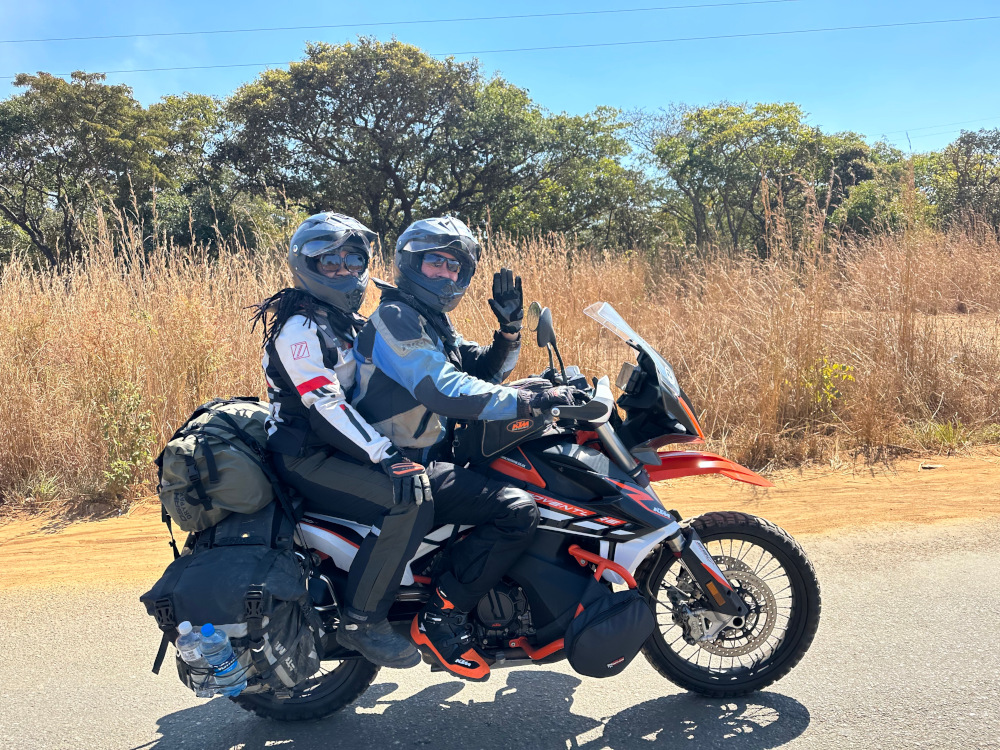
Tim has a tank bag for general small items as well as charging electrical goods (cell phones and laptops) via the Hela plug on the bike. He removed his rear seat and modified that space to carry further heavy kit that would damage the panniers on rough terrain. That luggage was locked within a “Pacsafe” wire mesh system. Carolyn packed her rear seat with two 7L fuel bags (in Pacsafes too) for those places where fuel stations may have run out or where we would need to do more than 400km at a time without fuel availability.
Navigation and planning
We have now ridden 13 African countries on our bikes – and loved them all, particularly when getting out of the towns and cities into the more rural areas. We always navigate using our Garmin 590 motorbike unit, with Tracks4Africa maps downloaded. In the weeks before, we pre-prepared some routes on the laptop, while for others we managed on the unit itself. Be sure to be able to manage the actual device rather than needing to download from your laptop. Adventures of this nature always have unscheduled challenges and route changes.
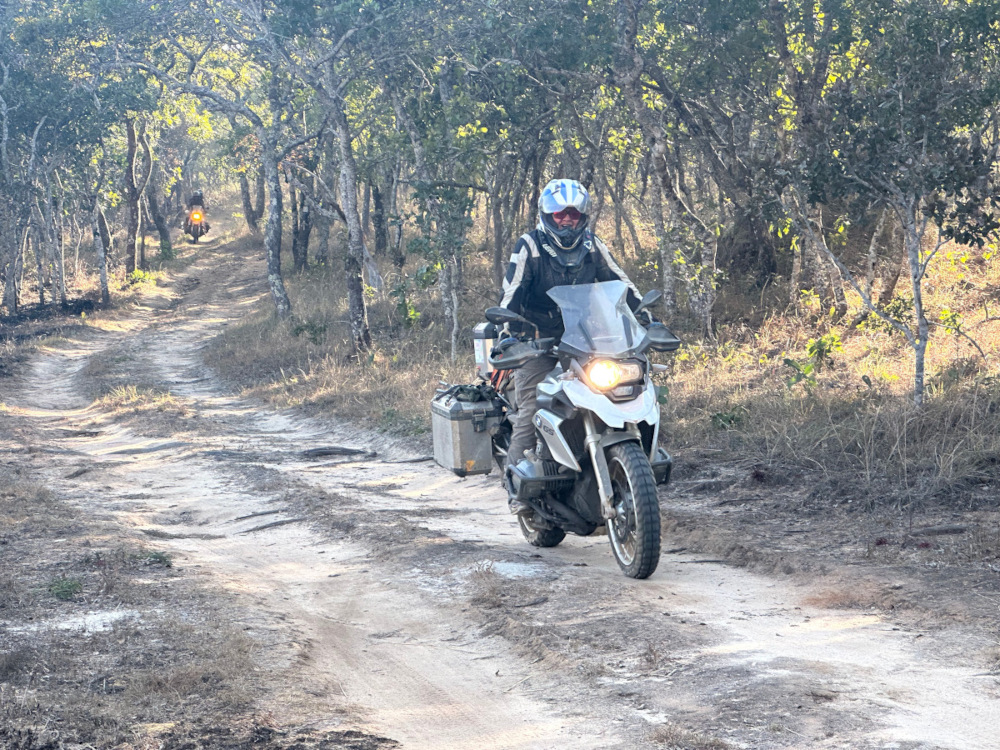
When planning an adventure motorcycle trip in southern Africa, one of the challenges remains getting into Big Five game parks. We have ridden through quite a few: in Tanzania (Mikumi, Saadani and Katavi national parks) and in Uganda (Queen Elizabeth National Park). But Zambia National Parks (probably correctly) does not allow motorbikes in parks such as South Luangwa and Liuwa Plain. So, if you are on two wheels and want to see wild animals, plan other gorgeous places such as ‘conservancies’ and the privately run parks. In most of these conservation areas it is legal – and the authorities don’t seem to mind if we get eaten by the animals or not. [Best to check before your travels if a specific park or conservancy permits motorbikes. – T4A]
Crossing the border at Kazungula
Getting through Kazungula Border Post was a treat on the Botswana side and extremely tedious on the Zambian side. There, collecting mountains of paper seems more important than real regulatory processing. The fantastic jointly run infrastructure on the southern aspect of the beautiful Kazungula Bridge over the Zambezi River houses both Botswana and Zambian officials. However, the level of inefficiency and administrative obfuscation on the Zambian side remains a challenge. But eventually, we ventured forth. Don’t let that stress you – who cares about three hours at the border when you have this magnificent country to explore for weeks thereafter!
We (Andrew, Carolyn and Tim) headed rapidly through Livingstone and stayed at a small budget place in Choma, The Oasis Evergreen Lodge, before picking up Malose at Kenneth Kaunda Airport in Lusaka. This was Malose’s first serious motorcycle adventure.
The Great North Road
The next day, we headed north to spend our first night camping at Fika Lodge (previously Forest Inn) just south of Mkushi. The Great North Road out of Lusaka is a mixture of everything, from beautiful tar to dirt to the most astonishing deep ruts made by the often overloaded trucks carrying mountains of copper and other minerals out of Zambia. It made the riding tricky, as hitting the outside of a deep rut can be dangerous on a bike. So, we rode much of the bad tar standing on the pegs as if it was a rutted dirt road, enabling us to deftly avoid the endless potholes, ruts and trucks.

Fika has good chalets and a lovely campsite, which has a shower that reminded us of standing directly under Victoria Falls… a story (including a crocodile scuttling down over Carolyn’s boogie board) for another time. We ate a good meal at their restaurant before falling into our tents early. The road was noisy, but quietened after 10pm when the trucks stop driving.
The delights of Kasanka National Park
Our intent was to get off the Great North Road as much as possible since the traffic and trucks are a special form of madness. So, we took an early start and turned north onto the D235 just after Serenje. What a relief to have a good road and minimal traffic all the way to the entrance of Kasanka National Park. Although the park does not normally allow motorcyclists in, we had prearranged entry with the management who were wonderful.

The ride into the reception area and onto the secluded campsite was lovely, with hard surface jeep track/tweespoorpaadjie. While we had booked the Kabwe Campsite, it was closed for repairs. So we stayed at the beautiful Pontoon Campsite, where each group has their own secluded area. Aside from the magnificent trees and ambiance, this campsite is special as every night you can see the rarely seen sitatunga. This very shy, aquatic antelope comes to graze and drink at the water’s edge adjacent the campsite. If you are lucky you will also see the blue monkeys that visit – not as intrusively as vervets.
Kasanka is famous for the annual bat migration between October and December each year, which we had seen before. [Do it – it is fabulous!!] So, it being July, we focused on a guided walking tour, which was fantastic, both for birds and land animals. The first night we awoke petrified as a herd of elephants walked through our campsite cracking large branches off as they went. They did nothing to us, but we did see Andrew making a massive fire before going to bed the second night and then augmenting it in the middle of the night.
Also read: Kasanka – a magical migration moment
Camping at WakaWaka
After a wonderful two days, we headed east from Kasanka towards the Bangweulu Swamps, opting not to visit the Livingstone memorial again. Our goal was to visit Nsobe Campsite, as we wanted to see a shoebill. However, the link road between Kasanka and the RD47 into Bangweulu was having a bad day. As a result, it took many hours more than anticipated to get through the sandy roads. Fortunately, Lake WakaWaka Campsite came out of nowhere and, despite the lack of facilities, we had somewhere to pitch our tents.

There are remnants of some chalets that remain, but these burned down some years back. A helpful campsite manager charged us $15 a person, which was probably a little steep, given that the derelict long drop was the only facility there. The mopane flies were unmanageable so we put up our tents and retreated until the day cooled and the flies disappeared. We ended our day perfectly with a tranquil swim/wash in the lake, which has no crocs nor hippos, followed by whiskey, supper and bed.
Hairy moments on the way to Mutinondo
The next day was a short ride south on the RD47 to the Great North Road and a short distance avoiding trucks to the turnoff for Mutinondo Wilderness. The road into Mutinondo is generally good, with little sand. Andrew did decide to fall on the one bad sandy patch, and was concussed reasonably badly. Malose was fortunately unhurt as the pillion rider.
These are difficult moments, as we would never continue riding after a significant concussion in different circumstances if we were nearer to assistance. However, remote places require extraordinary bravery at times – something Andrew does well. But critically, one just has to stop and ensure that nobody gets hurt any worse. Tim is a doctor, but has not seen a patient in more than 20 years; and gets pretty nervous around injured and sick people. After an hour and a half, Andrew was well enough to ride into the Mutinondo reception and onto the campsite.
Inselbergs and memories
At Mutinondo we stayed at Kankonde campsite. A beautiful spot adjacent to a stream and overlooking one of their famous granite inselbergs (large outcrops). Coming here was an emotionally-laden trip for all of us, as this is where our great friend, Anton Steenkamp, had been bitten by a black mamba in 2019 and subsequently died. Anton had been an adventure motorcycling buddy on so many trips together, since our first trip through East and Southern Africa in 2009.
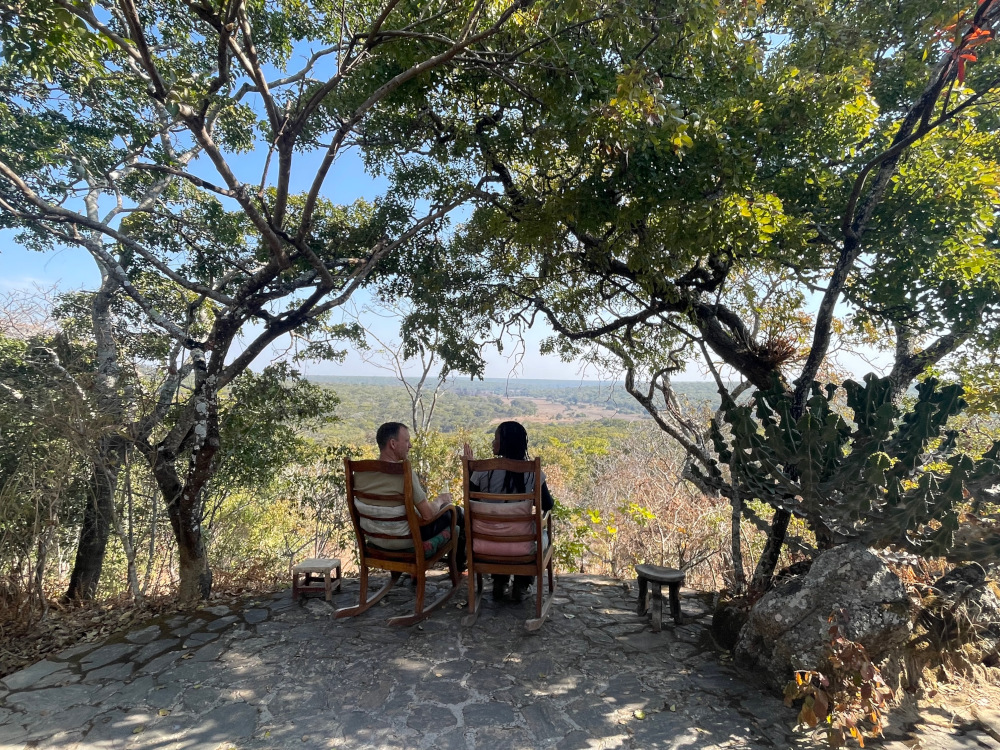
There is a bench placed in his honour at the campsite where he and Catherine were staying. It was a privilege to sit on the bench and watch both the sun and a “super” full moon rise over the bench. While drinking Anton’s favorite whiskey (Talisker), we recounted wonderful stories about our quirky, beautiful friend who died too young.
Mutinondo has an extraordinary landscape of granite inselbergs and dambos (grassy floodplains). It is a popular place to cycle, walk and swim – or just read a book. There are multiple campsites and chalets which are secluded and the landscape is stunning.
Kapishya Hot Springs and Shiwa Ng’andu
We approached Kapishya Hot Springs from the western side, after heading up the M1 at Mpika and turning east onto the lovely D53 dirt road. The Kapishya Campsite is situated on the edge of the Mansa River. It is scenic and well equipped with good amenities. The hot springs are magical, taking out the creases after the days of riding adventure motorbikes.
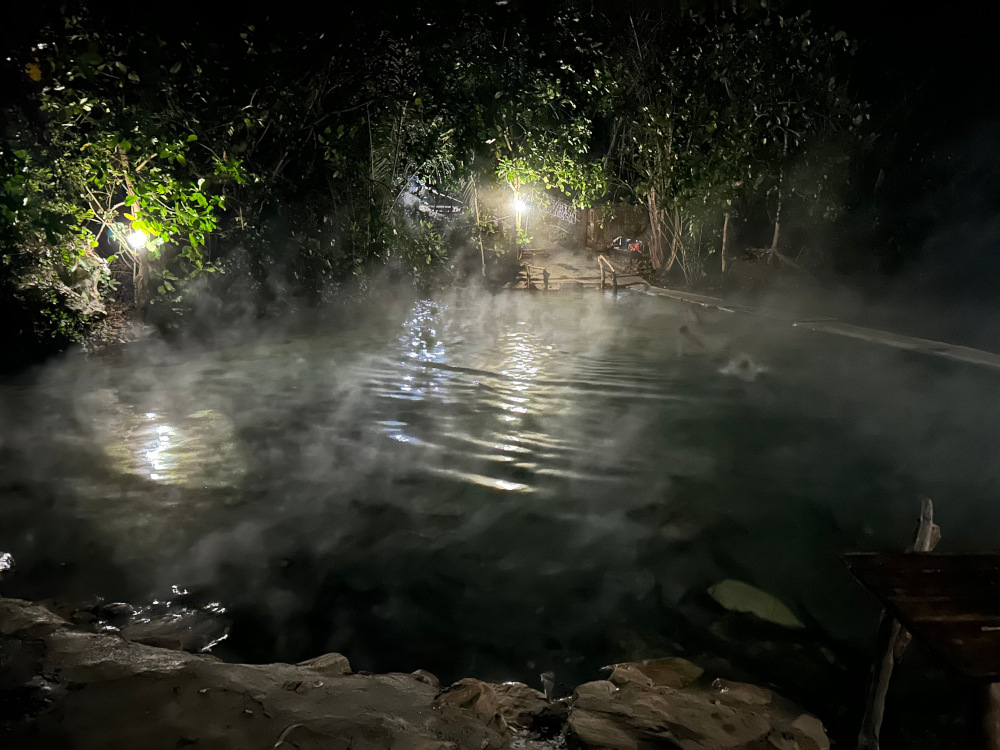
We had a delightful dinner on night 2 hosted by Mark and Mel Harvey, the owners of Kapishya. Mark became ecstatic when he realised Carolyn’s father was the same “Graham” who had both fixed his teeth as a dentist as well as published his favourite book. He ran off to collect Orchids of South Central Africa to show the rest of the visitors
Kapishya Hot Springs is part of the larger farming area where you can also find the colonial-style mansion, Shiwa Ng’andu, where you can have a tour and walk the farm. It is an astonishing, but obviously fatiguing, structure with a fascinating history.
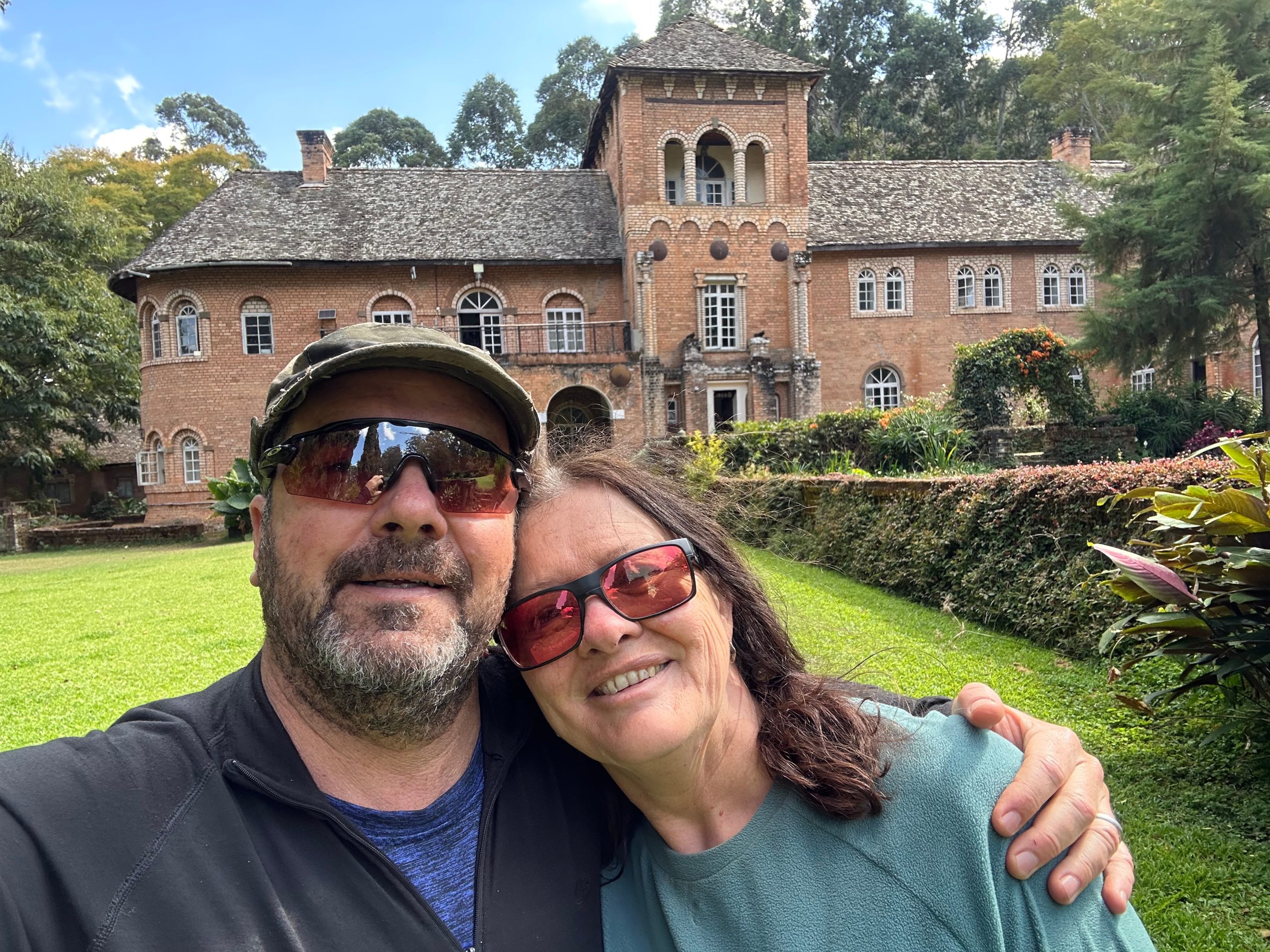
And then it was time to say goodbye. Andrew and Malose had far less time to travel, and they headed south to Lusaka and onwards to South Africa. As for Carolyn and Tim – they stayed another two nights to make sure all the creases were ironed out in the hot springs before heading further north.
Zambia route map
This map shows the route Tim and Carolyn followed.
- Part 1: Red track
- Part 2: Brown track

Stay tuned for “Zambia on two wheels part 2”, when Carolyn and Tim continue the trip north to Lake Tanganyika, the waterfall circuit of the north-west and back to Kazungula.
Handy tips for biking in Zambia
- Christo Naude runs a great motorbike transport company in the region. Tel 082 387 0049 Rcnbiketransport@gmail.com
- Zambian border crossing into the country needs lots of time for the laborious administrative processes.
- Don’t pack too much food – buy along the way. Rural villagers sell their vegetables in markets, and local tomato and garlic relish over braai-roasted potatoes tastes much better than supermarket food.
- Always have enough water in case of a change in plan requiring an overnight stay somewhere beside the road.
- Get to know your motorbike well before leaving. Ask your friendly mechanic to show you all the details of the metal, rubber and wires.
- Take a good (small) tool kit and medical kit.
- Camping is fantastic and you will generally have the place to yourself.
- Do an off-road training course – preferably an intermediate/advanced course – as you will need to ride very rough patches. A good road today can be washed away tomorrow.
- Be VERY careful on the Great North Road. It can be madness, and the trucks drive with absolutely no regard for motorbikes. Get off onto smaller roads as soon as possible. [There is hope that the state of the Great North Road will improve as there are several roadworks, especially north of Mpika. – T4A]
- Safety first!
